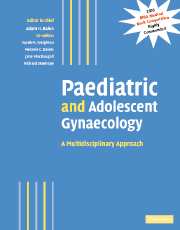Book contents
- Frontmatter
- Contents
- Contributors
- Preface
- Part I Normal development
- 1 Embryology of the female genital tract
- 2 Molecular genetics of gonad development
- 3 Gonadotrophin receptors
- 4 Normal childhood, puberty and adolescence
- 5 Control of the menstrual cycle and fertility
- 6 Nutrition and reproductive function
- 7 Normal bladder control and function
- 8 Development of sexuality: psychological perspectives
- Part II Management of developmental abnormalities of the genital tract
- Part III Management of specific disorders
- Index
- Plate section
- References
1 - Embryology of the female genital tract
from Part I - Normal development
Published online by Cambridge University Press: 04 May 2010
- Frontmatter
- Contents
- Contributors
- Preface
- Part I Normal development
- 1 Embryology of the female genital tract
- 2 Molecular genetics of gonad development
- 3 Gonadotrophin receptors
- 4 Normal childhood, puberty and adolescence
- 5 Control of the menstrual cycle and fertility
- 6 Nutrition and reproductive function
- 7 Normal bladder control and function
- 8 Development of sexuality: psychological perspectives
- Part II Management of developmental abnormalities of the genital tract
- Part III Management of specific disorders
- Index
- Plate section
- References
Summary
Introduction
Regardless of their sex, all human embryos initially develop a common set of genital structures. A pair of primordial gonads, the genital ridges, appear in both males and females during the sixth week of embryonic life. Two associated ducts develop, the Müllerian and Wollfian ducts, while presumptive external genitalia appear as folds of cloacal tissue. The fate of these undifferentiated internal and external structures depends upon the genetic sex of the embryo. In individuals with an XY sex chromosome constitution, the genital ridges become testes. Hormones released from the developing testes masculinize the internal ducts and external genitalia. Sertoli cells of the fetal testes synthesize anti-Müllerian Hormone (AMH; also known as Müllerian inhibitory substance), which induces Müllerian duct regression. Meanwhile, testosterone secretion from Leydig cells induces Wolffian duct differentiation into vas deferens, and virilization of the external genitalia into penis and scrotum. Testis differentiation is initiated by the SRY gene (sex-determining region of the Y chromosome). In individuals with an XX sex chromosome constitution, SRY is absent and the genital ridges differentiate as ovaries rather than testes. Furthermore, in the absence of AMH and testosterone, the ducts follow alternative developmental paths. In the absence of AMH, the Müllerian ducts are free to differentiate into the Fallopian tubes, uterus and upper portion of the vagina. In the absence of testosterone, the Wolffian ducts regress. The external genitalia of female embryos differentiate into clitoris and labia.
- Type
- Chapter
- Information
- Paediatric and Adolescent GynaecologyA Multidisciplinary Approach, pp. 3 - 8Publisher: Cambridge University PressPrint publication year: 2004
References
- 2
- Cited by

